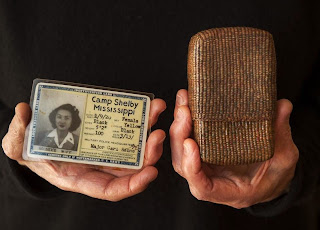I'm not talking about day camp or summer camp. In WW2, after the Japanese bombed Pearl Harbor,
120,000 people of Japanese ancestry were moved to internment camps away from the western coast.
Most of them were American citizens.
What does this have to do with a basketry blog? A few years, my friend Aimee and I saw an exhibit at the Portland Historical Museum, featuring art that was created in the camps. A book by Delphine Hirasuna,
The Art of Gaman: Arts and Crafts from the Japanese Internment Camps 1942-46 highlights many items.
http://www.amazon.com/Art-Gaman-Japanese-Internment-1942-1946/dp/1580086896/ref=sr_1_1?ie=UTF8&qid=1431290343&sr=8-1&keywords=art+internment+camps,
In Ms. Hirasuna's book, I found several baskets made from materials the internees happened to have around. Crepe paper and string from onion sacks were woven into lovely baskets. Then, after a controversial auction came up to sell Japanese American artwork made in the camps, other photos appeared. I would like to share some with you:
 |
These 4 photos are from Ms. Hirasuna's book.
This one shows the basket weaver and her ID card. Note that her race is "Yellow," and she is listed as a soldier's wife. Her husband was most likely in the segregated 442nd Regimental combat team in Europe, while she was in a camp surrounded by barbed wire. | | |
|
|
|
|
|
 |
| More cigarette cases made from onion sack strings. Many internees had 'jobs' for which they received pennies a day. Teachers, nurses, and other professionals were needed in these communities. But in their free time, they wanted to create something beautiful. They used what they could find, and offered classes to teach the others. Painting, music, gardening, wood carving, and more helped them pass the days while waiting in the unknown. | | |
|
|
 |
I made a reproduction of one of the baskets in the 3rd photo. I used wire and crepe paper, as the original artist did. I later found out that she is still alive!
Then I made a Northwest version of the cigarette case. Mine is made of western red cedar bark and artificial sinew. They will be on display May 22nd, at the Many Nations Long House, University of Or. for the Day of Remembrance/Tule Lake Pilgrimage Scholarship Night. |
|








No comments:
Post a Comment